Margaret of Austria, Duchess of Savoy
| Margaret of Austria | |
|---|---|
| Princess of Asturias Duchess of Savoy | |
 Portrait of Margaret as a widow painted by Bernard van Orley | |
| Governor of the Habsburg Netherlands | |
| Reign | 1507–1530 |
| Predecessor | William de Croÿ |
| Successor | Mary of Austria |
| Born | 10 January 1480 |
| Died | 1 December 1530 (aged 50) Mechelen, Duchy of Brabant |
| Spouse | |
| House | Habsburg |
| Father | Maximilian I, Holy Roman Emperor |
| Mother | Mary, Duchess of Burgundy |
| Religion | Roman Catholic |
| Signature | |
Archduchess Margaret of Austria (German: Margarete; French: Marguerite; Dutch: Margaretha; Spanish: Margarita; 10 January 1480 – 1 December 1530) was Governor of the Habsburg Netherlands from 1507 to 1515 and again from 1519 to 1530. She was the first of many female regents in the Netherlands.
Childhood and life in France[]
Margaret was born on 10 January 1480 and named after her stepgrandmother, Margaret of York. She was the second child and only daughter of Maximilian of Austria (future Holy Roman Emperor) and Mary of Burgundy, co-sovereigns of the Low Countries. In 1482, her mother died and her three-year-old brother Philip the Handsome succeeded her as sovereign of the Low Countries, with her father as his regent.
The same year her mother died, King Louis XI of France signed the Treaty of Arras, whereby her father promised to give her hand in marriage to Louis' son, Dauphin Charles. The engagement took place in 1483. With Franche-Comté and Artois as her dowry, Margaret was transferred to the guardianship of Louis XI, who died soon after. She was raised as a fille de France and prepared for her future role as Queen of France.
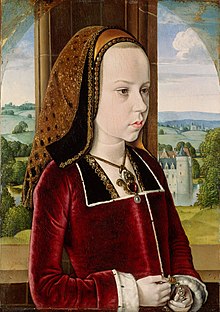
Under the supervision of her governess Madame de Segré, and Charles' sister, regent of France Anne de Beaujeu, Margaret received a fine education alongside several noble children, amongst whom was Louise of Savoy.[1]
Although their union was political, the young Margaret developed a genuine affection for Charles. However, he renounced the treaty in the autumn of 1491 and forcibly married Margaret's former stepmother Anne, Duchess of Brittany, for political reasons. The French court had ceased treating Margaret as their future queen but she could not return to her ex-stepmother's (Anne of Brittany) court until June 1493 after the Treaty of Senlis had been signed in May that year. She was hurt by Charles' actions and was left with a feeling of enduring resentment towards the House of Valois.
Marriages[]
Princess of Asturias[]
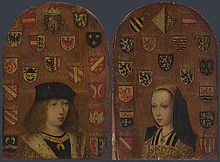
In order to achieve an alliance with Queen Isabella I of Castile and King Ferdinand II of Aragon, Maximilian started negotiating the marriage of their only son and heir, John, Prince of Asturias, to Margaret, as well as the marriage of their daughter Juana to Philip. Margaret left the Netherlands for Spain late in 1496. Her engagement to the Prince of Asturias seemed doomed when the ship carrying her to Spain hit a storm in the Bay of Biscay. In haste, she wrote her own epitaph should she not reach Spain:
"Here lies Margaret, the willing bride,
Twice married - but a virgin when she died."
However, Margaret actually married Prince John on 3 April 1497 in Burgos Cathedral. Tragically, John died of a fever after only six months, on 4 October. Margaret was left pregnant but gave birth to a premature stillborn daughter on 2 April 1498.[2]
Duchess of Savoy[]
In 1501, Margaret married Philibert II, Duke of Savoy (1480–1504), whose realm played a decisive role in the rivalry between France and the Habsburgs in Italy on account of its strategic position in the Western Alps.
By 1504, Philibert died of pleurisy. Grief-stricken, Margaret threw herself out of a window, but was saved. After being persuaded to bury her husband, she had his heart embalmed so she could keep it with her forever.[3]
Her court historian and poet Jean Lemaire de Belges gave her the title "Dame de deuil" (Lady of Mourning).[4]
Governor of the Habsburg Netherlands[]

Queen Isabella died in late 1504, and Philip and Juana went to Castile to claim the crown. After Philip's death, Charles was the new sovereign of the Low Countries, but he was young and alone. Juana could not return to act as regent because her unstable mental state and her Castilian subjects would not allow their ruler to abandon the kingdom. Preoccupied with German affairs, the now Emperor named Margaret governor of the Low Countries and guardian of Charles in 1507, along with her nieces Eleanor, Isabella and Mary. She became the only woman elected as its ruler by the representative assembly of Franche-Comté, with her title confirmed in 1509.
Although her mother was a previous sovereign of the Netherlands, Margaret was always considered a foreigner because of her childhood at the French court. The Governess served as an intermediary between her father and her nephew's subjects in the Netherlands from her newly built palace at Mechelen. During a remarkably successful career, she broke new ground for women rulers.[5]

In 1520, Charles made Margaret his governor-general in gratitude for her services. She was the only regent he ever re-appointed indefinitely from 1519 until her death in on 1 December 1530.[6]
Economy[]

Margaret had an aptitude for business, and maintained the prosperity of the Netherlands. She negotiated the restoration of Intercursus Magnus with England, which was favorable to the Flemish textile interests and brought huge profits.[7][8] Because of the trade, industry and wealth of the regions and cities she oversaw, the Low Countries was an important source of income for the Imperial treasury.
Margaret provided funds and war supplies for her nephew's troops, especially against King Francis I of France and the German Protestants. In following years, Habsburg forces consolidated their hold over Tournai, Friesland, Utrecht, and Overijssel, which became part of the Netherlands.
Internal conflict[]
Although the Low Countries was not previously centralized, Margaret's reign was a period of relative peace for the Netherlands. The exception was the beginning of the Protestant Reformation, especially in the north. The first martyrs were burnt at the stake in 1523.
Foreign policy[]
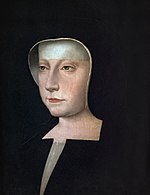
Margaret soon found herself at war with France over the question of Charles's requirement to pay homage to the French king for Flanders as Duke of Burgundy. In response, she persuaded Emperor Maximilian to end the war with King Louis XII. On November 1508, she journeyed to Cambrai to form the League of Cambrai, which the possibility of a French invasion of the Low Countries.[7][8]
Margaret and Charles began to negotiate the latter's election as Holy Roman Emperor despite the papacy and French's opposition. The Governess instead supported her younger nephew Ferdinand. However, Charles refused to withdraw. Using a combination of diplomacy and bribery, she played a crucial role in the election of Charles as Holy Roman Emperor in 1519.[7][8]
Journeying to Cambrai again in 1529, Margaret reunited with Louise of Savoy, his sister-in-law and mother of Francis I. They negotiated the end of a war that France could no longer sustain.
Patronage of the arts[]
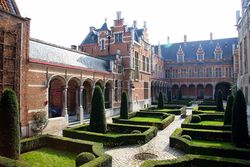
Once she was declared Governor of the Netherlands, Margaret purchased the Hof van Savoye, located in the Korte Maagdenstraat (Virgins Short Street). She found the residence too small and started an ambitious expansion campaign in 1507. From 1517 to 1530, the architect Rombout II Keldermans furthered the project along the Keizerstraat (Emperor Street) and modified what became the rear wing, which faces the Palace of Margaret of York. The Governess kept several painters at her court, including the Master of the Legend of the Magdalen and Pieter van Coninxloo.
Margaret possessed a rich library, consisting mostly of missals, poetry, historical and ethical treatises, which included the works of Christine de Pizan and the famous illuminated Très Riches Heures du duc de Berry.[9] She possessed several Chansonniers[10] which contained works by Josquin des Prez, Johannes Ockeghem, Jacob Obrecht and Pierre de la Rue, who was her favourite composer.
Margaret ended up raising her nephew and nieces in her palace. Her court was visited by the great humanists of her time, including Erasmus, Adrian of Utrecht (later Pope Adrian VI), and Heinrich Cornelius Agrippa.[11][12] Agrippa dedicated his arguably feminist work "Declamation on the Nobility and Preeminence of the Female Sex" to her.[13] The Governor was so impressed with diplomat Thomas Boleyn's charm that she offered his daughter Anne Boleyn (future Queen consort of England) a temporary place in her household. She reported to the English nobleman that the little girl was "so presentable and so pleasant, considering her youthful age, that I am more beholden to you for sending her to me, than you to me."
Margaret ordered several splendid music manuscripts from Pierre Alamire to send them as gifts to her relatives and political relations.[14] She had one of the earliest collections of objects from the New World. Hernán Cortés had presented Charles V with treasures received from the Aztec King Moctezuma in 1519. Several of these treasures were sent to Mechelen as a gift from her nephew in 1523.[15]
Portraits[]

Margaret of Austria c. 1500. Attributed to Pieter van Coninxloo.

Margaret of Austria Worshipping by Anonymous (Southern Netherlands) between 1500 and 1510; Museum of Fine Arts, Ghent.
Death and Burial[]

She was buried alongside her second husband at Bourg-en-Bresse, in the mausoleum of the Royal Monastery of Brou that she previously commissioned.[16] There is a statue of the Governess next to the Cathedral of Mechelen.
Heraldry[]

Arms as a single lady (before 1496)
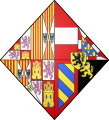
Arms as princess of Spain (1496-1501)

Arms as duchess of Savoy (after 1501)

Arms as countess of Burgundy and Artois (after 1509)
Depiction in media[]
Margaret of Austria is portrayed by Spanish actress Úrsula Corberó in the TV show Isabel.[17]
A fictionalized version of Margaret can be found in the play The Unhappy Penitent by Catharine Trotter, where she appears as the character 'Margarite'. In the play, Margarite is in love with René II, Duke of Lorraine, although this may be a historical inaccuracy since there is no indication available today that the two ever met. Also, the Duke of Brittany is in love with Margarite, but this likely another historical inaccuracy since he died in 1488, three years before Anne came to France to marry Charles VIII; her father's death is what spurred the various betrothals of Anne.
Ancestry[]
| showAncestors of Margaret of Austria, Duchess of Savoy |
|---|
References[]
- ^ Diana Maury Robin, Anne R. Larsen and Carole Levin (2007). Encyclopedia of women in the Renaissance: Italy, France, and England. ABC-CLIO, Inc. p. 43.CS1 maint: uses authors parameter (link)
- ^ N. de Aragón in: geneall.net [retrieved 7 October 2015].
- ^ Jansen, Sharon L. (2002). The Monstrous Regiment of Women: Female Rulers in Early Modern Europe. p. 88.
- ^ Gonkdo, Michal (2006). Dame de Deuil. Musical Offerings for Marguerite of Austria (1480-1530), 3. CD Booklet KTC 4011
- ^ Enno van Gelder, H.A. en Van Houtte, J.A. (1971). Margaretha van Oostenrijk, in: Grote Winkler Prins, vol. 12, p. 610-611. Amsterdam, Elsevier.
- ^ Enno van Gelder, H.A. en Van Houtte, J.A. (1971). Margaretha van Oostenrijk, in: Grote Winkler Prins, vol. 12, p. 610-611. Amsterdam, Elsevier.
- ^ Jump up to: a b c Jansen 2002, p. 94.
- ^ Jump up to: a b c Tremayne 1918, p. 240.
- ^ Schreurs, Eugeen; Vendrix; Philippe (2005). The sweet melancholy of Margaret, translated by Celia Skrine, 11. CD Booklet MEW 0525.
- ^ Schreurs, Eugeen (1998). Margarete – Maximilian I, translated by Stratton Bull, 14. CD Booklet ORF CD 265.
- ^ Tremayne, Eleanor E. (1918). The First Governess of the Netherlands, Margaret of Austria. Library of Alexandria. p. 379. ISBN 9781465517579.
- ^ Triest, Monica (2000). Macht, vrouwen en politiek 1477-1558. Maria van Bourgondië, Margaretha van Oostenrijk, Maria van Hongarije. Leuven, Van Halewijck.
- ^ LeGates, Marlene (2012). In Their Time: A History of Feminism in Western Society. Routledge. p. 111. ISBN 9781136779039.
- ^ Kellman, Herbert (ed.) (1999). The Treasury of Petrus Alamire. Music and Art in Flemish Court Manustricpts 1500-1535. Leuven, Die Keure.
- ^ MacDonald, Deanna (2002). "Collecting a New World: The Ethnographic Collections of Margaret of Austria". The Sixteenth Century Journal. 33 (3): 649–663. doi:10.2307/4144018. JSTOR 4144018.
- ^ "Brou". Centre des monuments nationaux. Retrieved 2018-03-04.
- ^ "Personaje Margarita de Austria". RTVE. Retrieved 2 March 2016.
- ^ Jump up to: a b Holland, Arthur William (1911). . In Chisholm, Hugh (ed.). Encyclopædia Britannica. 17 (11th ed.). Cambridge University Press.
- ^ Jump up to: a b c d Poupardin, René (1911). . In Chisholm, Hugh (ed.). Encyclopædia Britannica. 5 (11th ed.). Cambridge University Press.
- ^ Chisholm, Hugh, ed. (1911). . Encyclopædia Britannica. 11 (11th ed.). Cambridge University Press.
- ^ Urban, William (2003). Tannenberg and After. Chicago: Lithuanian Research and Studies Center. p. 191. ISBN 0-929700-25-2.
- ^ Jump up to: a b c d e f Stephens, Henry Morse (1903). The story of Portugal. G.P. Putnam's Sons. p. 139. Retrieved 11 July 2018.
- ^ Jump up to: a b Kiening, Christian (1994). "Rhétorique de la perte. L'exemple de la mort d'Isabelle de Bourbon (1465)". Médiévales (in French). 13 (27): 15–24. doi:10.3406/medi.1994.1307.
- ^ Jump up to: a b Wurzbach, Constantin, von, ed. (1860). . Biographisches Lexikon des Kaiserthums Oesterreich [Biographical Encyclopedia of the Austrian Empire] (in German). 6 – via Wikisource.
- ^ Jump up to: a b Wurzbach, Constantin, von, ed. (1860). . Biographisches Lexikon des Kaiserthums Oesterreich [Biographical Encyclopedia of the Austrian Empire] (in German). 6. p. 158 – via Wikisource.
- ^ Jump up to: a b "Leonora of Aragon (1405–1445)". Women in World History: A Biographical Encyclopedia. Gale Research. Retrieved 11 July 2018.
- ^ Jump up to: a b Chisholm, Hugh, ed. (1911). . Encyclopædia Britannica. 21 (11th ed.). Cambridge University Press.
- ^ Jump up to: a b Anselme de Sainte-Marie, Père (1726). Histoire généalogique et chronologique de la maison royale de France [Genealogical and chronological history of the royal house of France] (in French). 3 (3rd ed.). Paris: La compagnie des libraires. p. 137.
- ^ O'Reilly, Elizabeth Boyle (1921). How France Built Her Cathedrals. London: Harper Brothers Publishers. p. 265.
The present choir of Moulins Cathedral, originally the chapel of their palace, was built by Agnes of Burgundy, daughter of Jean sans Peur [John the Fearless]
Bibliography[]
| Wikimedia Commons has media related to Margaret of Austria. |
- Margarete - Maximilian I. Musik um 1500, Capilla Flamenca with La Caccia, Schola Cantorum Cantate Domino Aalst, Schola Gregoriana Lovaniensis, 1998, ORF Shop CD 265 (2 CDs).
- Dulcis Melancholia, Biographie musicale de Marguerite d'Autriche, Capilla Flamenca, 2005 (MEW 0525).
- Dame de Deuil. Musical Offerings for Marguerite of Austria, La Morra, 2005 (KTC 4011).
- Diana Maury Robin, Anne R. Larsen and Carole Levin (2007). Encyclopedia of women in the Renaissance: Italy, France, and England. ABC-CLIO, Inc.CS1 maint: uses authors parameter (link)
- . Encyclopædia Britannica. 17 (11th ed.). 1911. p. 703.
- Jansen, Sharon L. (2002). The Monstrous Regiment of Women: Female Rulers in Early Modern Europe. Palgrave Macmillan. ISBN 0-312-21341-7.
- Margaret of Austria (1480–1530) Encyclopedia
- 1480 births
- 1530 deaths
- 15th-century House of Habsburg
- 16th-century House of Habsburg
- Austrian princesses
- Austrian Roman Catholics
- Princesses of Asturias
- House of Trastámara
- 16th-century women rulers
- Duchesses of Savoy
- Governors of the Habsburg Netherlands







